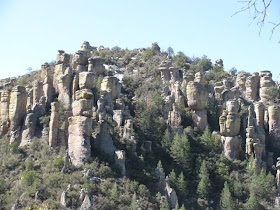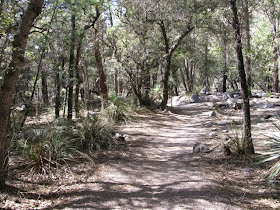Last year I visited 9 caves of various sorts, but I missed Kartchner Caverns. But I was going to be in the area and decided from all I had heard, the visit would be worth it. Found in 1974 by 2 amateur cavers, they kept it secret for 4 years. Then they let the owners of the land, the Kartchner's, know about the cavern. But it continued to be kept secret until 1988 when the state of Arizona purchased it from the Kartchner's to be developed as a state park. The reason for secrecy was so it would not be contaminated and destroyed. After the state purchased the property they spent 4 years studying the cave before developing it for viewing by the public. It was another 7 years, or not until 1999, before it actually opened to the public.

No cameras or photos are allowed on the tour. They are concerned about the potential for the 300-600 people per day, and all the flash photography causing damage. They do have the most strict rules of any cave I have been in. A rather small cave system compared to many, it is only 2 1/2 acres of cave system. 2/3 have been developed. There are 2 caves for viewing, but one cave, The Big Room, is also the nursery of a local bat population, so it is closed from April-October. The other cave, The Throne Room/Rotunda, is open all year. Controlling the number of visitors it is best to have reservations. Many times the tours are booked weeks in advance. When both tours are operating they can take up to 600 people through the caves per day.
I toured both caves and personally I didn't think they were the best I've been it, but they were pretty. My first tour guide was not very good and even though he has been giving these tours since 2002, he didn't answer the questions well and barely told us anything about the caves. But on the second cave tour of the Throne Room/Rotunda, the guide was excellent. If you can only choose one cave tour, choose the Throne Room/Rotunda, and not just because I had a good guide. There was more variety and formations than the other cave.
Before my reservations for the caverns, I visited Fort Huachuca in Sierra Vista, just south of Kartchner Caverns.
 |
| This building was completed in 1892, but the fort was established as a temporary camp in 1877. The U.S. Army brought in the first troops in 1849 to protect the pioneers and settlers heading to California for the gold rush. Over the next 30 years many small forts were established because of the problems with some of the native tribes. |
 |
| All 4 of the Buffalo Soldier regiments spent time at the fort over the years. |
 |
| Indian Scouts were used by the army in the mid 1800s, but were not offically recognized until 1866. Since they tracked enemy bands and others by reading the lay of the land and other signs, some consider the Indian Scouts some of the first military intelligence. |
In 1916 troops from the fort marched against Pancho Villa in the Mexican/American War.
General Pershing, George Patton, William Donovan, George Marshall and Omar Bradley. What did all these men have in common? They were all important military commanders, who early in their careers, prior to 1917, served here on the border.
In later years Fort Huachuca became known for its importance in the military intelligence community. In 1954, after being shut down for 7 months following the Korean War, it opened the Army Electronic Proving Ground. The U.S. Army Signal Command took its headquarters at Fort Huachuca in 1967 and today most military intelligence training is conducted here.
I personally found the Military Intelligence Museum as interesting as that about the fort itself.
 |
| This machine is the Enigma, an electro mechanical cipher used by the Nazi's, who thought it's code to be unbreakable. But early in WWII the British broke the code, keeping this information secret. The intelligence learned by decrypting Engima messages was known as ULTRA. |
Other cold war tradecraft were:































































